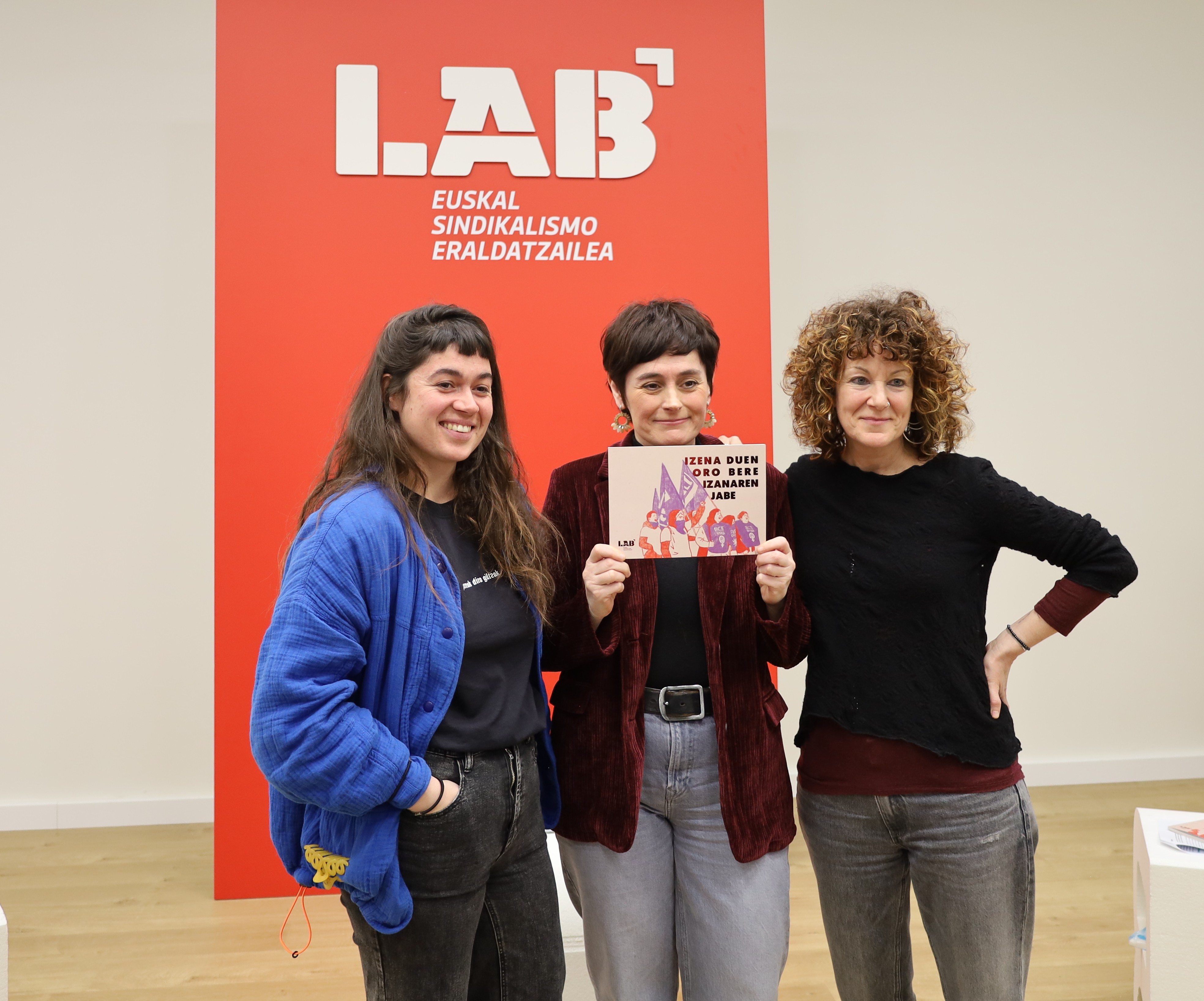Thorns and flowers in spring against male violence
- Party protocols, feminist self-defense initiatives, awareness campaigns..., along with the summer, campaigns against the sexist attacks that are being worked on throughout the year are being revealed once again this year. This is not a flower that sprouts suddenly, but a flowering of the seed planted year after year and well nourished.

Unfortunately, the multiple expressions of macho violence do not cease. And to this already brutal violence is added the irresponsible treatment of information in many media: judging the behavior of women, fully associating women with the image of the victim or deepening morbidity. It is sometimes unclear whether various gatherings have the effect of sensitizing the public, or whether they reinforce the discourse of fear and create new patterns for the aggressors. How many gang rapes have occurred at the state level since that disgusting incident in Sanfermin?
In this context, the Women’s World March of the Basque Country (EMM) aims to launch a series of ideas and questions for reflection. We urgently need to make an analysis of the forms of response that are being deployed within the Feminist Movement in the face of sexist violence, which from now on must be complemented collectively with caution.
We have seen the mobilizing muscle of feminism clearly this year. The Feminist Movement has long been mobilizing the pulsation of society, making a radical critique of predatory neoliberalism, removing the mask of the patriarchal system and using its skill for political articulation. There is no doubt that the 8th of March of this year has reached the point of a deep collective rage that has accumulated and has led us to co-incarnate a common restlessness that was in the trunk. In the face of the abyss, we firmly crushed the brake during the feminist strike.
However, the destructive heteropatriarchal machinery advances with the help of the machista violence tool. Feminism has rightly explained that this violence cannot be read as a tragedy that occurs in isolation, or left behind at the expense of evil men, because it is a deeply rooted structure. That is, the macho violence is recreated and valued in the main pillars of the system: the state, the media, families, the labor market, etc.
Taking the case of La Manada as an example, although it has been presented to us in the form of an exceptional event by the five wild beasts, it is only a piece of bread from the daily bread. The response he received was absolutely extraordinary. Because the rape that occurred in the portal and in the court of Pamplona has exposed the fraud of an entire generation that seems to live in equality. The streets (both physical and virtual) have vibrated with the screams of #HauEzDaJusticia or #Self-Defense Feminist.
This flood offers interesting elements to analyze the trends of participation, mobilization and activism that are spreading in feminism: the spontaneity of responses, phenomena fueled by media and social networks or anonymous calls that are made without taking into account the local Feminist Movement. It seems that the initiatives that emerge from the indignation of the population, with the help of networks, tend to distance themselves from the mediation of organized groups. This reduces the margins for organized feminisms to analyze the situation, determine the discourse and make proposals. These mass overflows, being more disjointed, could also be more useful for the system. For example, at a time when the Spanish state is in an authoritarian drift and wants to strengthen the prison place, will it try to absorb feminism to root punitivist positions? Could this lead to the emptying of the political potential of feminism? We'll have to pay attention.
The tension “The strength of the punctual moments vs. the daily muscle” is evident. We need both or both. The waves of the moment allow us to form new collectivities, overcome the media veto and popularize our languages and conceptions. But the sustained coordination and ant work of the Feminist Movement is also needed to drive fundamental changes.
It is curious that alongside such massive phenomena, other forms of violence remain relatively unnoticed. Macho murders, for example, usually bring together 50 people in the capitals of the Basque Country in the best cases.Why is this so if murder is an extreme expression of macho violence? It seems that we have integrated the macho murders into our daily lives and that the numbers of women who kill us do not impress us. This raises a lot of questions, so: Have we normalized femicide? Or are there a number of outdated forms of response? Are viral campaigns on networks heard more than calls from feminist groups?
On the other hand, the passion for mobilization has been different, depending on who is attacked. Two months ago, shortly after the day of La Manada’s provisional sentence, we learned of the insults, blackmail and rapes suffered systematically by Moroccan women working in the strawberry fields of Huelva. In this case, we mobilized less. This shows that, rather than proclaiming the intersectionality of the feminist movement in the discursive field, we still need to carry it out in the practical field. What kind of women are feminists? What lives matter more to us than others? The challenge of answering these questions is on the table, and for this it is essential to carry out a collective reflection and review of the privileges of white feminists, if we are to build a radical feminism.
We have begun the process of addressing the challenges facing us at the RMC. On the one hand, we have broadened the concept of violence and begun to define the discursive framework of inter-system violence. There are different levels of vulnerability among women to violence and they are expressed in different ways in our bodies. This renewed conception helps us to reveal these differences in order to provide exchanges of ideas about new practices. In this sense, we are carrying out special elaborations with some groups: women with functional diversity, immigrant women and/or young women, among others, to receive experiences of violence that we often do not see.
Along with this, spaces have been opened to revitalize the protocol against macho killings that the MRC has been operating since 2013 (every time a woman with a life project in the Basque Country is murdered and 24 hours often calls for gatherings in the cities and towns of the Basque Country) and to review the forms of response from people to people. It has become clear that to overcome the routine we need new models of struggle that give way to emotions, corporeality, memory and creativity. This process is also aimed at strengthening alliances; because we need multiple and articulated responses to address diverse violence, and for that, collaboration.
The fight against sexist violence is not a flower that has sprouted from night to day, that is why from the MRC we thank the feminist groups and members that have sustained this fight in the last decades, as well as all the popular agents, as well as social and political actors that have made this fight their own. It is clear that feminist self-defense and the leadership of the Feminist Movement (which will not tolerate the cooptation of anyone) in the fight against aggression remains the backbone. The night is still long, but we are lighting it with flowers, anchovies and solidarity nets!! !
This wedge that the announcement on the radio Euskadi to replace the bathtub with a shower encourages the commencement of the works in the bathroom of the house. A simple work, a small investiture and a great change are announced. There has been a shift in toilet trends and a... [+]
Zalantza asko izan ditut, meloia ireki ala ez. Ausartuko naiz, zer demontre! Aspaldian buruan dudan gogoeta jarri nahi dut mahai gainean: ez da justua erditu den emakumearen eta beste gurasoaren baimen-iraupena bera izatea. Hobeto esanda, baimen-denbora bera izanda ere, ez... [+]
Goldatz talde feministak antolatua, ortziralean, urtarrilaren 3an, Jantzari dokumentala proiektatuko dute Beralandetan (17:30ean) eta biharamunean, urtarrilaren 4an, Berako bestetako tradizioak aztergai izanen dituzte Maggie Bullen antropologoarekin leku berean (10:30).
Ander Magallon, Mikel Irure eta Xabier Jauregi Metropoli Forala saioan egon dira maskulinitate berrien inguruan mintzatzen.



















